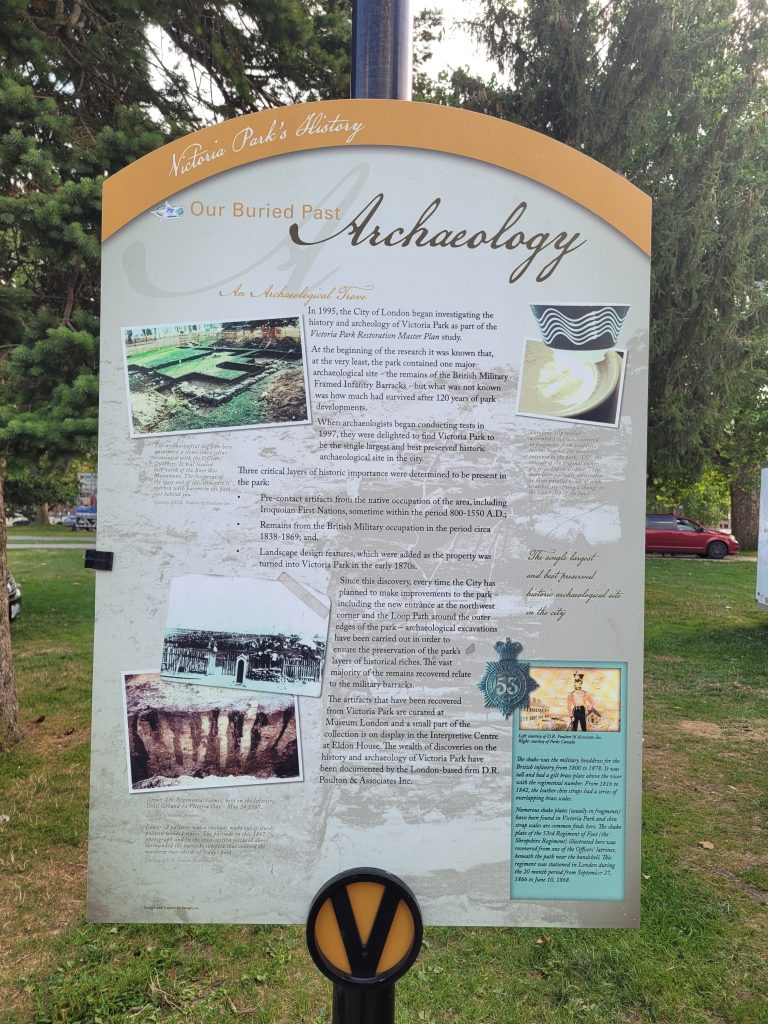In 1995, the City of London began investigating the history and archaeology of Victoria Park as part of the Victoria Park Restoration Master Plan study.
At the beginning of the research it was known that, at the very least, the park contained one major archaeological site (the remains of the British Military Framed Infantry Barracks), but what was not known was how much had survived after 120 years of park developments.
When archaeologists began conducting tests in 1997, they were delighted to find Victoria Park to be the single largest and best preserved historic archaeological site in the city.
Three critical layers of historic importance were determined to be present in the park:
-
Pre-contact artifacts from the native occupation of the area, including stone tools.
-
Remains from the British Military occupation in the period circa 1838–1869; and,
-
Landscape design features, which were added as the property was turned into Victoria Park in the early 1870s.
Since this discovery, every time the City has planned to make improvements to the park (including the new entrance at the northwest corner and the Loop Path around the outer edges of the park), archaeological excavations have taken place in order to ensure the preservation of the park’s cultural artifacts. The vast majority of the remains recovered relate to the military barracks.
The artifacts that have been recovered from Victoria Park are curated at Museum London and a small part of the collection is on display in the Interpretive Centre at Eldon House. The wealth of discoveries on the history and archaeology of Victoria Park have been documented by the London-based firm D.R. Poulton & Associates Inc.
The single largest and best preserved historic archaeological site in the city
When you stroll through Victoria Park in downtown London, Ontario, you’re walking on more than just grassy pathways and picnic spots — you’re walking on history.
In 1995, the City of London kicked off a deep dive into the park’s buried secrets as part of the Victoria Park Restoration Master Plan. What began as a restoration project quickly turned into one of the city’s most significant archaeological finds.
At the heart of the discovery were the remains of the British Military’s Framed Infantry Barracks, structures dating back to the 1830s. Though historians knew the park was once a military site, the extent of what had survived underfoot for more than 120 years was astonishing.
By 1997, when test digs began, archaeologists confirmed that Victoria Park was home to the largest and best-preserved historic archaeological site in London. Three layers of artifacts were uncovered:
Pre-contact Indigenous artifacts
Military-era remains (1838–1869)
Victorian landscape features added when the park was established in the 1870s
Every time the city considers upgrades to the park, like installing new paths or improving entrances, archaeological teams are called in first. Their mission? Protect and preserve what’s left of this important historical site.
Artifacts from the digs are housed at Museum London and the Eldon House Interpretive Centre, where visitors can see tools, remnants of buildings, and learn about London’s transformation from military outpost to modern city park.
The excavation work has been led and documented by D.R. Poulton & Associates Inc., bringing Londoners a vivid look at the lives once lived where today we relax, eat ice cream, and attend festivals.
So next time you find yourself under the shade of a tree in Victoria Park, remember — beneath your feet lies a story of soldiers, settlers, and centuries past.

